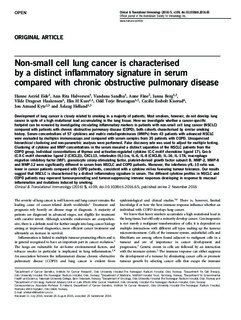| dc.contributor.author | Eide, Hanne Astrid | |
| dc.contributor.author | Halvorsen, Ann Rita | |
| dc.contributor.author | Sandhu, Vandana | |
| dc.contributor.author | Fåne, Anne | |
| dc.contributor.author | Berg, Janna | |
| dc.contributor.author | Haakensen, Vilde Drageset | |
| dc.contributor.author | Kure, Elin H. | |
| dc.contributor.author | Brustugun, Odd Terje | |
| dc.contributor.author | Kiserud, Cecilie E. | |
| dc.contributor.author | Kyte, Jon A | |
| dc.contributor.author | Helland, Åslaug | |
| dc.date.accessioned | 2018-02-22T10:26:28Z | |
| dc.date.available | 2018-02-22T10:26:28Z | |
| dc.date.created | 2016-11-23T14:56:08Z | |
| dc.date.issued | 2016 | |
| dc.identifier.citation | Clinical & translational immunology. 2016, 5 . | nb_NO |
| dc.identifier.issn | 2050-0068 | |
| dc.identifier.uri | http://hdl.handle.net/11250/2486371 | |
| dc.description.abstract | Development of lung cancer is closely related to smoking in a majority of patients. Most smokers, however, do not develop lung cancer in spite of a high mutational load accumulating in the lung tissue. Here we investigate whether a cancer-specific footprint can be revealed by investigating circulating inflammatory markers in patients with non-small cell lung cancer (NSCLC) compared with patients with chronic obstructive pulmonary disease (COPD), both cohorts characterised by similar smoking history. Serum concentrations of 57 cytokines and matrix metalloproteinases (MMPs) from 43 patients with advanced NSCLC were evaluated by multiplex immunoassays and compared with serum samples from 35 patients with COPD. Unsupervised hierarchical clustering and non-parametric analyses were performed. False discovery rate was used to adjust for multiple testing. Clustering of cytokine and MMP concentrations in the serum revealed a distinct separation of the NSCLC patients from the COPD group. Individual concentrations of thymus and activation-regulated cytokine (C-C motif chemokine ligand 17), Gro-b (C-X-C motif chemokine ligand 2 (CXCL2)), CXCL13, interleukin (IL)-1ra, IL-6, IL-8 (CXCL8), IL-16, IL-17A, macrophage migration inhibitory factor (MIF), granulocyte colony-stimulating factor, platelet-derived growth factor subunit B, MMP-2, MMP-8 and MMP-12 were significantly different in serum from NSCLC and COPD patients. Moreover, the interferon-γ/IL-10 ratio was lower in cancer patients compared with COPD patients, consistent with a cytokine milieu favouring tumour tolerance. Our results suggest that NSCLC is characterised by a distinct inflammatory signature in serum. The different cytokine profiles in NSCLC and COPD patients may represent tumour-promoting and tumour-suppressing immune responses developing in response to mucosal inflammation and mutations induced by smoking. | nb_NO |
| dc.language.iso | eng | nb_NO |
| dc.rights | Navngivelse 4.0 Internasjonal | * |
| dc.rights.uri | http://creativecommons.org/licenses/by/4.0/deed.no | * |
| dc.title | Non-small cell lung cancer is characterised by a distinct inflammatory signature in serum compared with chronic obstructive pulmonary disease | nb_NO |
| dc.type | Journal article | nb_NO |
| dc.type | Peer reviewed | nb_NO |
| dc.description.version | publishedVersion | nb_NO |
| dc.rights.holder | The Authors 2016 | nb_NO |
| dc.source.volume | 5 | nb_NO |
| dc.source.journal | Clinical & translational immunology | nb_NO |
| dc.identifier.doi | 10.1038/cti.2016.65 | |
| dc.identifier.cristin | 1403425 | |
| cristin.unitcode | 222,58,1,0 | |
| cristin.unitname | Institutt for natur, helse og miljø | |
| cristin.ispublished | true | |
| cristin.fulltext | original | |
| cristin.qualitycode | 1 | |

